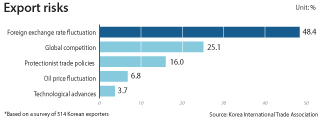Korea’s exporters fear volatile exchange rates

According to a survey by the business lobbying group on 514 Korean exporters that sold over $500,000 overseas last year, 67.9 percent of respondents said they are suffering from foreign exchange loss as the Korean won has been strengthening recently.
Nearly half of the respondents also believed the risk of foreign exchange rate fluctuation will linger until next year. Currency risk refers to financial risk caused by fluctuations in exchange rates.
Exports from agriculture and major manufacturing industries like textiles, machinery, petroleum, shipbuilding and electronics were expected to be hit especially hard.
The Korean won, which used to be traded at around 1,147 won per dollar in September strengthened to hit 1,088.3 won per dollar on Dec. 5 and 1,092 won per dollar on Dec. 14. The U.S. dollar is currently the most commonly used currency for the majority of Korean exporters, followed by the euro, Japanese yen and Chinese yuan.
Despite recent losses, Korean exporters weren’t effectively gearing up against currency risk, according to the trade body. While 58.4 percent of respondents said they don’t have any measures to manage risk from foreign exchange rate fluctuation, only 8.6 percent said they have an in-house expert on foreign exchange rates.
“The won-dollar exchange rate is falling even though the U.S. Federal Reserve recently decided to raise interest rates,” said Kim Keon-woo, a researcher for the analysis and forecasting office at KITA. “In case the Korean won continues to be strong, Korean companies need to craft strategies to manage foreign exchange risk in the long-term and to nurture experts in foreign exchange rates.”
Other than risks from foreign exchange rates, Korean exporters also picked heated global competition as one of the largest risk factors for the upcoming year. Protectionist policies from the U.S. and China as well as oil price fluctuation were also cited as possible risks.
Despite the risks, 91.4 percent of respondents expected next year’s export sales to grow.
According to KITA, exports of medical precision tools, semiconductors and machinery are highly likely to grow in 2018. However, exports of mobile phones, parts for mobile devices, electronics and agriculture are expected to slow down.
In the first nine months of this year, exports from Korea grew by 18.5 percent year on year, the largest rate in six years.
Thanks to the increase, Korea exceeded $1 trillion in trade volume for the first time in three years.
BY KIM JEE-HEE [kim.jeehee@joongang.co.kr]










with the Korea JoongAng Daily
To write comments, please log in to one of the accounts.
Standards Board Policy (0/250자)